Scientific name Belemnitida | Higher classification Cephalopod Rank Order | |
 | ||
Similar Ammonites, Cephalopod, Molluscs, Brachiopod, Ichthyosaur | ||
Belemnitida (or belemnites) is an extinct order of cephalopods which existed during the Mesozoic era, from the Hettangian age of the Lower Jurassic to the Maastrichtian age of the Upper Cretaceous. The belemnite is the state fossil of Delaware.

Description
Belemnites were superficially squid-like. They possessed ten arms of equal length studded with small inward-curving hooks used for grasping prey. However, they lacked the pair of specialized tentacles present in modern squid.
Belemnites (and other belemnoids) were distinct from modern squid by possessing hard internal skeletons. The internal skeleton was composed of the guard or rostrum (plural: rostra), a heavy solid structure at the posterior of the animals. The rostrum was usually bullet-shaped and projects prominently backward, but in the suborder Belemnotheutina, it was only present as a thin layer. While the inherited camerate portion of the internal skeleton (see below) was of aragonite, the evolutionarily novel rostrum was composed of calcite. Due to its more geologically stable calcite constitution, the rostrum is often the only remains of the animals preserved, often in very large numbers in a given area.
The rostrum is in turn attached to a chambered conical shell known as the phragmocone. At the tip of the phragmocone beneath the rostrum is a tiny spherical or cuplike nodule known as the protoconch, the remains of the embryonic shell. The space between the phragmocone and the rostrum is known as the alveolus (plural: alveoli). At the forward part of the phragmocone is a thin very fragile structure known as the proostracum (plural: proostraca). It is usually spoon-like in shape. It extends over the dorsal part of the mantle.
Fossils which preserve the soft parts of belemnites indicate that like modern coleoids, they possessed an ink sac, hard beaks, tail fins that were either apical or lateral, and large eyes. Additionally they had a pro-ostracum which is a tongue-like projection from the main body of the shell. Well preserved specimens have even retained evidence of strong muscular fibers in the mantle, indicating that they were powerful swimmers like modern squid and unlike other cephalopods of their time such as ammonoids and cymatoceratid nautiloids.
